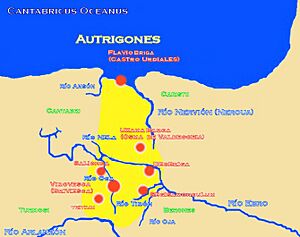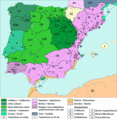Autrigones facts for kids
The Autrigones were an ancient tribe that lived in the northern part of the Iberian Peninsula (modern-day Spain) long before the Romans arrived. Their home was mainly in what is now the western Basque Country (parts of Biscay and Álava) and northern Burgos. They also lived in the eastern part of Cantabria.
Their land bordered other tribes: the Cantabri to the west, the Caristii to the east, the Berones to the southeast, and the Turmodigi to the south. Historians debate if the Autrigones were Celts. This idea is supported by some of their place names, like Uxama Barca, and others ending in -briga, which are common in Celtic languages. Over time, they might have become more like the Basques, similar to their neighbors, the Caristii and Varduli.
Contents
Where They Lived
Ancient Roman writers like Pomponius Mela and Pliny the Elder wrote about the Autrigones. They placed them in the northern area of what is now the Province of Burgos. Pliny the Elder even mentioned "ten states of the Autrigones." He said the most important towns were Tritium Autrigonum (which might be Monasterio de Rodilla, Burgos) and Virovesca (possibly Briviesca, Burgos).
Other towns of the Autrigones included:
- Deobriga (near Miranda de Ebro, Burgos)
- Uxama Barca (Osma de Valdegobia)
- Segisamunculum (Cerezo del Riotirón, Burgos)
- Antecuia (near Pancorbo, Burgos)
- Vindeleia (Cubo de Bureba, Burgos)
- Salionca (Poza de la Sal, Burgos)
- The port of Portus Amanus or Flaviobriga (Castro Urdiales, Cantabria)
Their Beginnings
The Autrigones are first mentioned in a Roman document by the historian Livy in 76 BC. This document described the actions of Quintus Sertorius in the Iberian Peninsula. Another historian, Strabo, called them allótrigones in his book Geographica. This Greek word means "strange people."
Many experts believe the Autrigones were a Celtic tribe. This is based on studying their place names, just like with the Caristii and Varduli. For example, Uxama Barca in Álava and many other names ending in -briga are Celtic. River names like the Nervión, personal names, and archaeological finds (like tools and weapons) also link them to the Celts. However, they were still different from other nearby Celtic tribes, such as the Celtiberians.
Their Culture
The Autrigones shared a culture with the "Monte Bernorio-Miraveche" group from the early Iron Age. This group lived in northern Burgos and Palencia provinces. Later archaeological discoveries show that by the 2nd Iron Age, the Autrigones were influenced by the Celtiberians.
By the 1st century BC, they had organized themselves into a group of ten independent towns. These towns were built on mountaintops in the upper Ebro region. They were protected by strong mud-brick walls, similar to those found in the ancient city of Numantia.
More archaeological finds highlight their Celtiberian culture. One interesting example is the "hospitality tesserae." These were special metal tablets shaped like animals. They had inscriptions written in a form of the Northeastern Iberian script (also called Celtiberian script) and in the Celtiberian language. These tablets were used to show friendship and alliances between people.
Their History
Around the beginning of the 4th century BC, the Autrigones moved into the Iberian Peninsula. They took over the area that is now Cantabria and Burgos. This region later became known as Autrigonia. By the mid-4th century BC, they reached the Pisuerga valley and set up their capital, Autraca, near the Odra River.
They also gained access to the sea. They took the coastal area between the Asón and Nervión rivers from the Aquitanian-speaking Caristii. This region is now in eastern Cantabria, Vizcaya, and Álava.
However, the Autrigones did not keep this large territory for long. Sometime after 300 BC, they were pushed out of southern Autrigonia (the western Burgos region). This happened when the Turmodigi tribe, allied with the Vaccei, took over Autraca. Pushed back to their lands in the mountains of the upper Ebro around the 3rd-2nd Centuries BC, the Autrigones formed an alliance with the Berones. They developed into a tribal society similar to other peoples in the northwest. By the 1st century BC, they were a group of ten independent towns. Their new capital was Virovesca, located in the Oca river valley.
Becoming Roman
The Autrigones did not seem to take part in the Celtiberian Wars. However, they were traditional allies of the Berones. They helped the Berones fight off the Roman general Sertorius' attack in northern Celtiberia in 76 BC. The Autrigones remained independent until the late 1st century BC. At that time, increasing attacks from the Astures and Cantabri tribes forced them to seek an alliance with Rome.
Even though they became part of the new Roman province called Hispania Tarraconensis in the early 1st century AD, the Autrigones only partly adopted Roman ways. They never became Christian. They continued to provide helper soldiers (called Auxilia) for the Roman Imperial army until the late Empire.
The Early Middle Ages
The Autrigone people survived the fall of the Roman Empire in Spain in the late 4th century. They briefly formed their own small kingdom again in parts of modern-day Burgos, Álava, and Biscay. This kingdom lasted for almost two centuries. However, they were eventually conquered by their Varduli neighbors. Around AD 580, they were either destroyed or joined with the Vascones tribe.
See also
 In Spanish: Autrigones para niños
In Spanish: Autrigones para niños
- Celtiberian script
- Cantabrian Wars
- Caristii
- Sertorian Wars
- Varduli
- Origin of the Basques
- Pre-Roman peoples of the Iberian Peninsula
Images for kids



